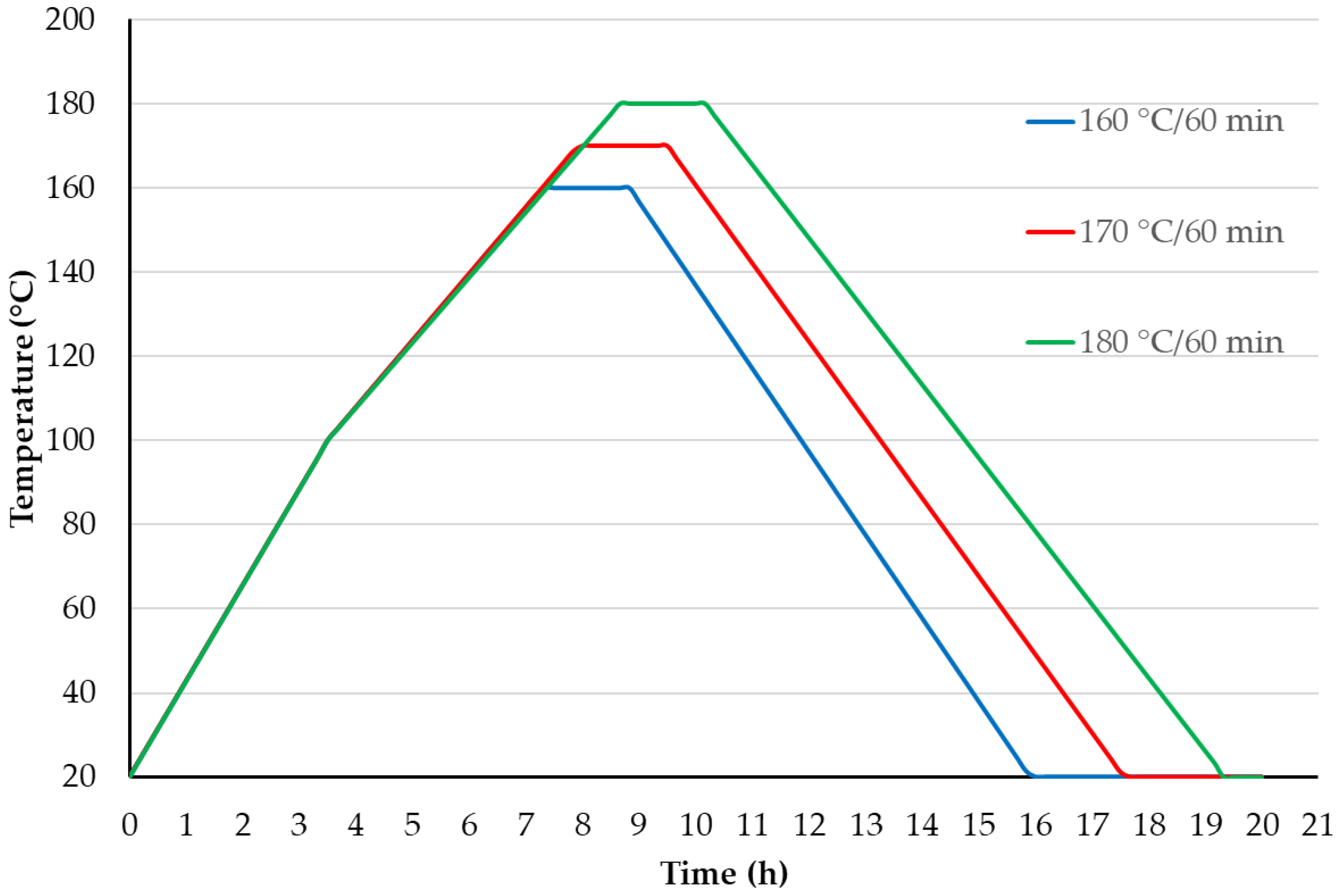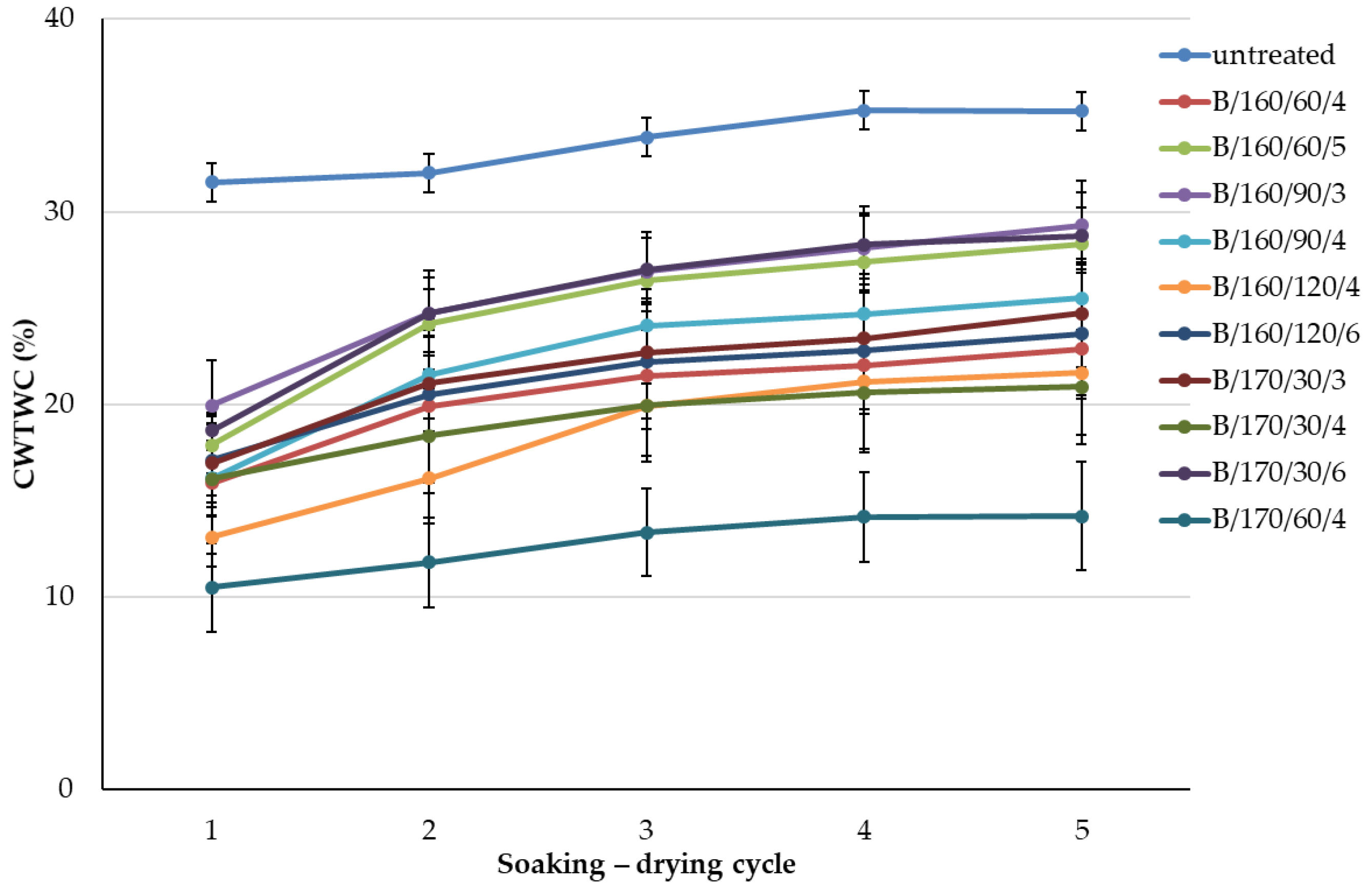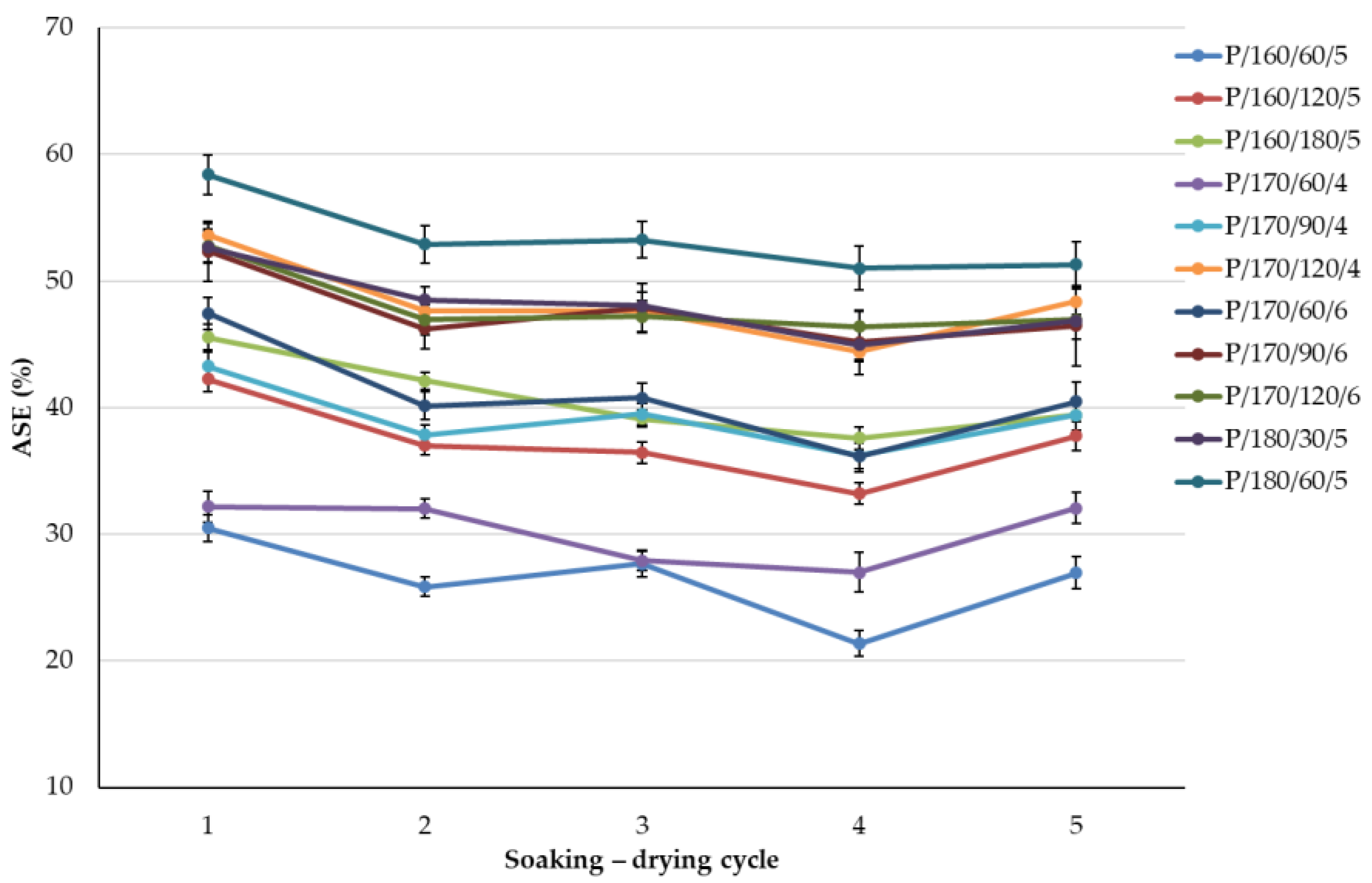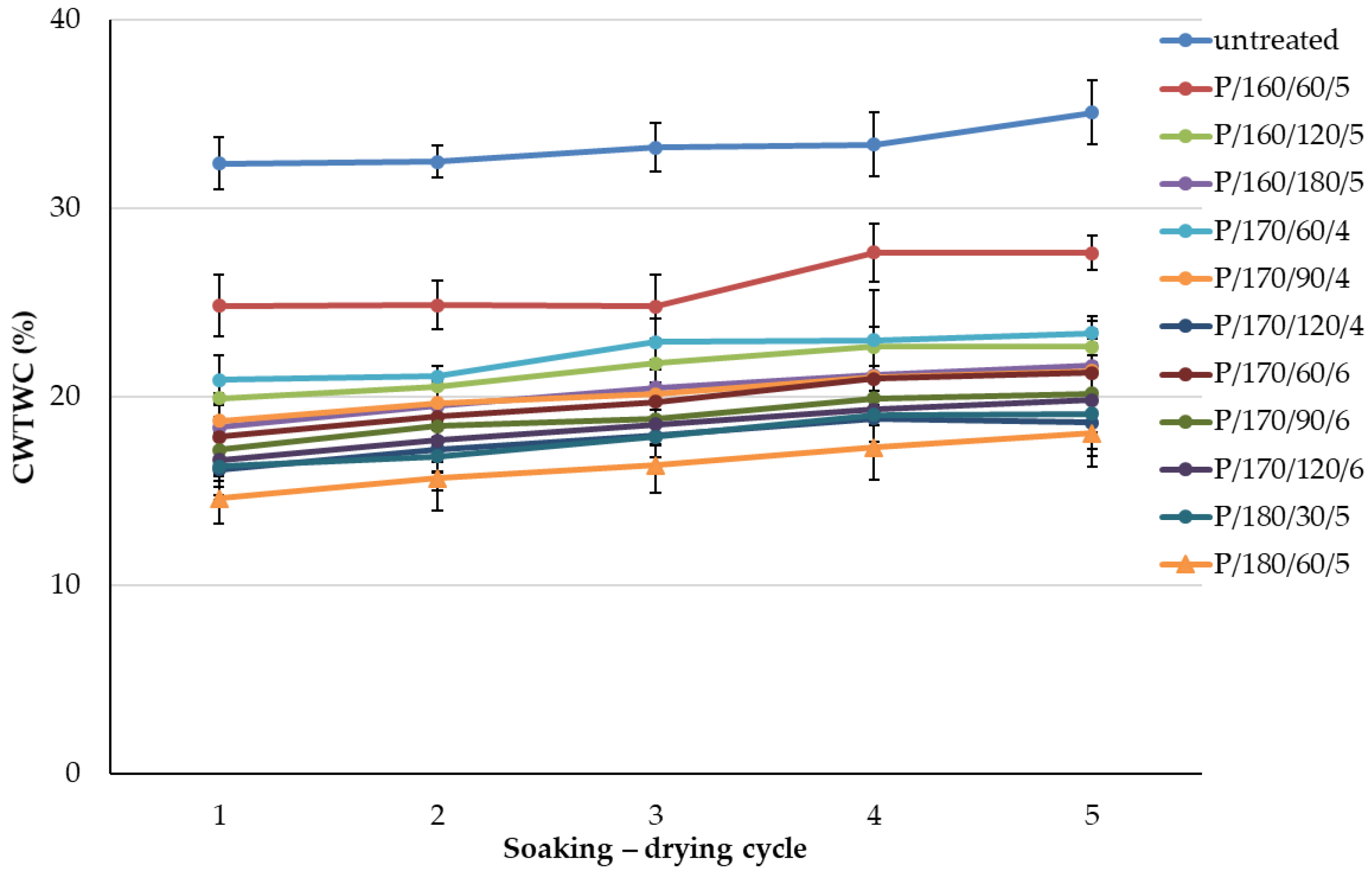Water-Related Properties of Wood after Thermal Modification in Closed Process under Pressure in Nitrogen
Abstract
:1. Introduction
2. Materials and Methods
2.1. Materials
2.2. Thermal Modification Process
2.3. Physical Parameters
- is the mass loss after TM in nitrogen [%];
- is the oven-dried mass of the boards before treatment [g];
- is the oven-dried mass of the boards after TM in nitrogen [g].
- is the in-wood volume changes after TM [%];
- is the conditioned wood board volume before TM [cm3];
- is the conditioned wood board volume after TM [cm3].
- is the length of the untreated wood’s longitudinal direction [cm];
- is the length of the untreated wood’s tangential direction [cm];
- is the length of the untreated wood’s radial direction [cm].
- is the length of the TM wood’s longitudinal direction [cm];
- is the length of the TM wood’s tangential direction [cm];
- is the length of the TM wood’s radial direction [cm].
2.4. Dimensional Stability
- is the anti-swelling efficiency [%];
- is the untreated specimens’ volumetric swelling coefficient;
- is the TM specimens’ volumetric swelling coefficient.
- is the volumetric swelling coefficient [%];
- is the wood volume after soaking with water [cm3];
- is the oven-dried wood volume before soaking with water [cm3].
- is the cell wall total water capacity [%];
- is the wood volume after soaking with water [cm3];
- is the volume of oven-dried wood [cm3];
- is the oven-dried mass of the specimens before each soaking cycle [g].
2.5. Moisture Uptake
- is the equilibrium moisture content [%];
- is the is the oven-dried mass of the specimen;
- is the equilibrium mass of the specimen after conditioning at a given RH.
- is the volumetric swelling [%];
- is the equilibrium volume of the specimen after conditioning at a given RH [cm3];
- is the oven-dried volume of the specimens before conditioning [cm3].
3. Results
3.1. Mass Loss and Physical Parameter Changes
3.2. Anti-Swelling Efficiency and Cell Wall Water Capacity
3.3. Equilibrium Moisture Content and Dimensional Changes
4. Discussion
5. Conclusions
Author Contributions
Funding
Data Availability Statement
Conflicts of Interest
References
- Jones, D.; Sandberg, D. A Review of Wood Modification Globally–Updated Findings from COST FP1407. Interdiscip. Perspect. Built Environ. 2020, 1, 1–31. [Google Scholar] [CrossRef]
- Jones, D.; Sandberg, D.; Goli, G.; Todaro, L. Wood Modification in Europe: A State-of-the-Art about Processes, Products and Applications, 1st ed.; Firenze University Press: Florence, Italy, 2020; Volume 124, ISBN 978-88-6453-970-6. [Google Scholar]
- Scheiding, W.; Ala-Viikari, J.; Tetri, T. Thermal Wood Modification after 20 Years of Commercialization: An Overview and the ThermoWood® Story. In Proceedings of the 10th European Conference on Wood Modification, Nancy, France, 25 April 2022; pp. 11–21. [Google Scholar]
- Zelinka, S.L.; Altgen, M.; Emmerich, L.; Guigo, N.; Keplinger, T.; Kymäläinen, M.; Thybring, E.E.; Thygesen, L.G. Review of Wood Modification and Wood Functionalization Technologies. Forests 2022, 13, 1004. [Google Scholar] [CrossRef]
- Sandberg, D.; Kutnar, A.; Mantanis, G. Wood Modification Technologies—A Review. iForest 2017, 10, 895–908. [Google Scholar] [CrossRef]
- Godinho, D.; Araújo, S.D.O.; Quilhó, T.; Diamantino, T.; Gominho, J. Thermally Modified Wood Exposed to Different Weathering Conditions: A Review. Forests 2021, 12, 1400. [Google Scholar] [CrossRef]
- Giebeler, E. Dimensional Stabilization of Wood by Moisture-Heat-Pressure Treatment. Holz Roh Werkst. 1983, 41, 87–94. [Google Scholar] [CrossRef]
- Feist, W.C.; Sell, J. Weathering Behavior of Dimensionally Stabilized Wood Treated by Heating under Pressure of Nitrogen Gas. Wood Fiber Sci. 1987, 19, 183–195. [Google Scholar]
- Pratiwi, L.A.; Darmawan, W.; Priadi, T.; George, B.; Merlin, A.; Gérardin, C.; Dumarçay, S.; Gérardin, P. Characterization of Thermally Modified Short and Long Rotation Teaks and the Effects on Coatings Performance. Maderas Cienc. Tecnol. 2019, 21, 209–222. [Google Scholar] [CrossRef]
- Chien, Y.-C.; Yang, T.-C.; Hung, K.-C.; Li, C.-C.; Xu, J.-W.; Wu, J.-H. Effects of Heat Treatment on the Chemical Compositions and Thermal Decomposition Kinetics of Japanese Cedar and Beech Wood. Polym. Degrad. Stab. 2018, 158, 220–227. [Google Scholar] [CrossRef]
- Tuong, V.M.; Li, J. Changes Caused by Heat Treatment in Chemical Composition and Some Physical Properties of Acacia Hybrid Sapwood. Holzforschung 2011, 65, 67–72. [Google Scholar] [CrossRef]
- Guimarães Carvalho, A.; Geike De Andrade, B.; Barros Donato, D.; Simões Da Silva, C.M.; De Cassia Oliveira Carneiro, A.; Resende De Castro, V.; Zanuncio, A.J.V. Bonding Perfomance of Structural Adhesives on Heat-Treated Mimosa Scabrella Andpinus Oocarpa Wood. Cellul. Chem. Technol. 2020, 54, 663–668. [Google Scholar] [CrossRef]
- Paes, J.; Brocco, V.; Loiola, P.; Segundinho, P.; Silva, M.; Juizo, C. Effect of Thermal Modification on Decay Resitance of Corymbia Citriodora and Pinus Taeda Wood. JTFS 2021, 33, 185–190. [Google Scholar] [CrossRef]
- Inari, G.N.; Pétrissans, M.; Pétrissans, A.; Gérardin, P. Elemental Composition of Wood as a Potential Marker to Evaluate Heat Treatment Intensity. Polym. Degrad. Stab. 2009, 94, 365–368. [Google Scholar] [CrossRef]
- Bytner, O.; Laskowska, A.; Drożdżek, M.; Kozakiewicz, P.; Zawadzki, J. Evaluation of the Dimensional Stability of Black Poplar Wood Modified Thermally in Nitrogen Atmosphere. Materials 2021, 14, 1491. [Google Scholar] [CrossRef] [PubMed]
- Nguyen, C.T.; Wagenführ, A.; Phuong, L.X.; Dai, V.H.; Bremer, M.; Fischer, S. The Effects of Thermal Modification on the Properties of Two Vietnamese Bamboo Species, Part I: Effects on Physical Properties. BioResources 2012, 7, 5355–5366. [Google Scholar] [CrossRef]
- Zhang, Y.; Xu, D.; Ma, L.; Wang, S.; Liu, X. Influence of Heat Treatment on the Water Uptake Behavior of Wood. BioResources 2017, 12, 1697–1705. [Google Scholar] [CrossRef]
- Bytner, O.; Drożdżek, M.; Laskowska, A.; Zawadzki, J. Temperature, Time, and Interactions between Them in Relation to Colour Parameters of Black Poplar (Populus Nigra L.) Thermally Modified in Nitrogen Atmosphere. Materials 2022, 15, 824. [Google Scholar] [CrossRef] [PubMed]
- Bytner, O.; Drożdżek, M.; Laskowska, A.; Zawadzki, J. Influence of Thermal Modification in Nitrogen Atmosphere on the Selected Mechanical Properties of Black Poplar Wood (Populus Nigra L.). Materials 2022, 15, 7949. [Google Scholar] [CrossRef] [PubMed]
- ISO 13061-1:2014; Physical and Mechanical Properties of Wood—Test Methods for Small ClearWood Specimens—Part 1: Determination of Moisture Content for Physical and Mechanical Tests. International Organization for Standardization: London, UK, 2014.
- ISO 13061-2:2014; Physical and Mechanical Properties of Wood—Test Methods for Small ClearWood Specimens—Part 2: Determination of Density for Physical and Mechanical Tests. International Organization for Standardization: London, UK, 2014.
- Biziks, V.; Andersons, B.; Sansonetti, E.; Andersone, I.; Militz, H.; Grinins, J. One-Stage Thermo-Hydro Treatment (THT) of Hardwoods: An Analysis of Form Stability after Five Soaking-Drying Cycles. Holzforschung 2015, 69, 563–571. [Google Scholar] [CrossRef]





| TM Process | Temperature (°C) | Process Duration (h) | Pressure (bar) | Atmosphere |
|---|---|---|---|---|
| Thermowood | 180–230 | 30–70 | Atmospheric | Steam |
| Feuchte–Wärme–Druck | 120–200 | 5–15 | 5–10 | Nitrogen |
| Plato | 150–190 | 70–120 up to 2 weeks | Super atmospheric pressure (partly) | Saturated steam/heated air |
| Wood treatment technology | 140–180 | 22–30 | 4–12 | Saturated steam |
| Le bois Perdure | 200–230 | 12–36 | Atmospheric | Steam |
| Firmolin | 160–180 | No data available | 4–7 | Saturated steam |
| Opel Therm Vacuum press dewatering method | 180–240 | 24–120 | 0.08 | Vacuum |
| Termovuoto | 160–220 | Up to 25 | 0.15–0.35 | Vacuum |
| Rétification process | 160–240 | 8–24 | No data available | Nitrogen |
| Oil–heat treatment | 180–220 | 24–36 | - | Vegetable oils |
| Wood treatment technology | 140–180 | 8–12 | 12–18 | Nitrogen |
| Treatment Regime | Tmax (°C) | Time at Tmax (min) | Initial Pressure (bar) | Max Pressure (bar) |
|---|---|---|---|---|
| B/160/60/4 | 160 | 60 | 4 | 11.8 |
| B/160/60/5 | 160 | 60 | 5 | 14.2 |
| B/160/90/3 | 160 | 90 | 3 | 10.0 |
| B/160/90/4 | 160 | 90 | 4 | 12.0 |
| B/160/120/4 | 160 | 120 | 4 | 12.6 |
| B/160/120/6 | 160 | 120 | 6 | 16.2 |
| B/170/30/3 | 170 | 30 | 3 | 12.7 |
| B/170/30/4 | 170 | 30 | 4 | 13.0 |
| B/170/30/6 | 170 | 30 | 6 | 16.9 |
| B/170/60/4 | 170 | 60 | 4 | 13.2 |
| Treatment Regime | Tmax (°C) | Time at Tmax (min) | Initial Pressure (bar) | Max Pressure (bar) |
|---|---|---|---|---|
| P/160/60/5 | 160 | 60 | 5 | 11.5 |
| P/160/120/5 | 160 | 120 | 5 | 12.7 |
| P/160/180/5 | 160 | 180 | 5 | 13.2 |
| P/170/60/4 | 170 | 60 | 4 | 12.5 |
| P/170/90/4 | 170 | 90 | 4 | 12.7 |
| P/170/120/4 | 170 | 120 | 4 | 12.9 |
| P/170/60/6 | 170 | 60 | 6 | 15.4 |
| P/170/90/6 | 170 | 90 | 6 | 15.8 |
| P/170/120/6 | 170 | 120 | 6 | 16.2 |
| P/180/30/5 | 180 | 30 | 5 | 16.4 |
| P/180/60/5 | 180 | 60 | 5 | 16.8 |
| Treatment Regime | Mass Loss (%) | Tangential Changes (%) | Radial Changes (%) | Volumetric Changes (%) |
|---|---|---|---|---|
| B/160/60/4 | 7.7 ± 2.7 | 4.4 ± 1.1 | 2.9 ± 1.2 | 7.1 ± 2.0 |
| B/160/60/5 | 9.5 ± 3.1 | 5.0 ± 1.3 | 3.8 ± 1.4 | 8.6 ± 2.4 |
| B/160/90/3 | 5.9 ± 2.2 | 4.4 ± 0.9 | 3.3 ± 0.8 | 7.5 ± 1.5 |
| B/160/90/4 | 7.3 ± 2.9 | 5.1 ± 1.4 | 4.2 ± 1.0 | 9.0 ± 2.1 |
| B/160/120/4 | 10.1 ± 1.7 | 5.9 ± 1.5 | 3.5 ± 1.1 | 9.1 ± 2.4 |
| B/160/120/6 | 12.0 ± 2.8 | 5.7 ± 1.6 | 4.7 ± 1.4 | 10.2 ± 2.6 |
| B/170/30/3 | 8.6 ± 2.6 | 5.5 ± 1.4 | 4.4 ± 1.2 | 9.6 ± 2.1 |
| B/170/30/4 | 9.6 ± 2.8 | 5.7 ± 1.3 | 3.6 ± 1.1 | 9.1 ± 2.2 |
| B/170/30/6 | 9.3 ± 2.9 | 5.3 ± 1.0 | 3.5 ± 1.0 | 8.7 ± 1.8 |
| B/170/60/4 | 12.0 ± 2.2 | 6.4 ± 1.0 | 4.1 ± 1.2 | 10.2 ± 2.0 |
| Treatment Regime | Mass Loss (%) | Tangential Changes (%) | Radial Changes (%) | Volumetric Changes (%) |
|---|---|---|---|---|
| P/160/60/5 | 2.6 ± 0.7 | 2.9 ± 0.3 | 1.5 ± 0.2 | 4.4 ± 0.4 |
| P/160/120/5 | 3.9 ± 0.9 | 3.6 ± 0.4 | 1.9 ± 0.3 | 5.4 ± 0.6 |
| P/160/180/5 | 4.7 ± 1.3 | 3.7 ± 0.5 | 2.1 ± 0.4 | 5.6 ± 0.7 |
| P/170/60/4 | 4.9 ± 1.0 | 3.5 ± 0.3 | 2.2 ± 0.3 | 5.6 ± 0.4 |
| P/170/90/4 | 6.6 ± 1.5 | 3.9 ± 0.5 | 2.2 ± 0.4 | 6.0 ± 0.7 |
| P/170/120/4 | 7.9 ± 1.3 | 4.2 ± 0.4 | 2.5 ± 0.3 | 6.6 ± 0.6 |
| P/170/60/6 | 6.3 ± 1.2 | 3.6 ± 0.5 | 2.0 ± 0.4 | 5.5 ± 0.7 |
| P/170/90/6 | 6.0 ± 1.3 | 3.2 ± 0.4 | 1.7 ± 0.3 | 4.9 ± 0.6 |
| P/170/120/6 | 7.8 ± 1.2 | 3.9 ± 0.5 | 2.3 ± 0.5 | 6.1 ± 0.8 |
| P/180/30/5 | 7.6 ± 1.6 | 3.9 ± 0.7 | 2.2 ± 0.4 | 6.0 ± 1.0 |
| P/180/60/5 | 9.0 ± 1.6 | 4.5 ± 0.5 | 2.5 ± 0.5 | 6.9 ± 0.8 |
| Treatment Regime | Relative Humidity (%) | |||||
|---|---|---|---|---|---|---|
| 65 | 75 | 98 | ||||
| EMC | VS | EMC | VS | EMC | VS | |
| Untreated | 9.6 ± 0.1 | 4.8 ± 0.3 | 12.9 ± 0.1 | 6.5 ± 0.4 | 17.4 ± 0.1 | 9.6 ± 0.6 |
| B/160/60/4 | 4.7 ± 0.9 | 2.1 ± 0.6 | 5.5 ± 1.0 | 2.4 ± 0.7 | 7.5 ± 1.0 | 3.3 ± 1.0 |
| B/160/60/5 | 4.6 ± 0.6 | 2.2 ± 0.4 | 5.4 ± 0.7 | 2.5 ± 0.5 | 7.4 ± 0.4 | 3.6 ± 0.7 |
| B/160/90/3 | 4.7 ± 0.5 | 2.5 ± 0.6 | 5.5 ± 0.8 | 2.9 ± 0.7 | 7.6 ± 0.8 | 4.6 ± 0.7 |
| B/160/90/4 | 4.5 ± 0.5 | 2.3 ± 0.4 | 5.3 ± 0.5 | 2.6 ± 0.5 | 7.2 ± 0.3 | 3.8 ± 0.7 |
| B/160/120/4 | 4.0 ± 0.5 | 1.7 ± 0.2 | 5.3 ± 0.5 | 2.4 ± 0.5 | 7.4 ± 1.0 | 3.2 ± 0.6 |
| B/160/120/6 | 4.3 ± 0.6 | 2.2 ± 0.3 | 5.6 ± 0.8 | 3.1 ± 0.5 | 7.5 ± 0.8 | 4.2 ± 0.8 |
| B/170/30/3 | 3.9 ± 0.3 | 1.9 ± 0.3 | 4.9 ± 0.4 | 2.8 ± 0.4 | 7.0 ± 0.6 | 3.9 ± 0.5 |
| B/170/30/4 | 4.0 ± 0.4 | 1.7 ± 0.2 | 5.1 ± 0.5 | 2.4 ± 0.4 | 7.4 ± 1.0 | 3.7 ± 0.5 |
| B/170/30/6 | 4.7 ± 0.5 | 2.5 ± 0.4 | 5.4 ± 0.8 | 2.9 ± 0.5 | 7.9 ± 0.7 | 4.4 ± 0.6 |
| B/170/60/4 | 3.7 ± 0.1 | 1.6 ± 0.2 | 4.6 ± 0.1 | 2.1 ± 0.3 | 6.6 ± 0.3 | 3.3 ± 0.5 |
| Treatment Regime | Relative Humidity (%) | |||||
|---|---|---|---|---|---|---|
| 65 | 75 | 98 | ||||
| EMC | VS | EMC | VS | EMC | VS | |
| Untreated | 10.3 ± 0.1 | 5.4 ± 0.2 | 13.1 ± 0.1 | 6.9 ± 0.3 | 17.6 ± 0.1 | 9.7 ± 0.5 |
| P/160/60/5 | 7.3 ± 0.3 | 3.8 ± 0.4 | 8.3 ± 0.3 | 4.3 ± 0.3 | 11.7 ± 0.5 | 6.4 ± 0.4 |
| P/160/120/5 | 6.3 ± 0.3 | 3.0 ± 0.2 | 7.8 ± 0.4 | 3.8 ± 0.2 | 10.6 ± 0.3 | 5.5 ± 0.4 |
| P/160/180/5 | 5.7 ± 0.4 | 2.7 ± 0.2 | 6.7 ± 0.5 | 3.2 ± 0.2 | 8.8 ± 0.5 | 4.6 ± 0.3 |
| P/170/60/4 | 6.1 ± 0.5 | 3.2 ± 0.4 | 7.1 ± 0.5 | 3.8 ± 0.5 | 9.8 ± 0.7 | 5.5 ± 0.6 |
| P/170/90/4 | 5.4 ± 0.4 | 2.9 ± 0.2 | 7.1 ± 0.5 | 3.9 ± 0.3 | 9.1 ± 0.4 | 5.3 ± 0.4 |
| P/170/120/4 | 4.9 ± 0.2 | 2.2 ± 0.4 | 6.2 ± 0.3 | 3.0 ± 0.4 | 8.4 ± 0.5 | 4.3 ± 0.7 |
| P/170/60/6 | 5.3 ± 0.4 | 2.6 ± 0.4 | 6.4 ± 0.5 | 3.1 ± 0.3 | 8.7 ± 0.6 | 4.6 ± 0.4 |
| P/170/90/6 | 5.0 ± 0.5 | 2.2 ± 0.5 | 6.0 ± 0.5 | 2.7 ± 0.5 | 8.0 ± 0.6 | 3.9 ± 0.8 |
| P/170/120/6 | 4.9 ± 0.4 | 2.2 ± 0.4 | 5.8 ± 0.5 | 2.7 ± 0.5 | 7.6 ± 0.8 | 3.7 ± 0.9 |
| P/180/30/5 | 4.8 ± 0.4 | 2.4 ± 0.3 | 5.6 ± 0.4 | 2.8 ± 0.3 | 7.5 ± 0.4 | 3.9 ± 0.4 |
| P/180/60/5 | 4.5 ± 0.2 | 2.2 ± 0.3 | 5.3 ± 0.2 | 2.5 ± 0.4 | 7.3 ± 0.6 | 3.8 ± 0.6 |
Disclaimer/Publisher’s Note: The statements, opinions and data contained in all publications are solely those of the individual author(s) and contributor(s) and not of MDPI and/or the editor(s). MDPI and/or the editor(s) disclaim responsibility for any injury to people or property resulting from any ideas, methods, instructions or products referred to in the content. |
© 2024 by the authors. Licensee MDPI, Basel, Switzerland. This article is an open access article distributed under the terms and conditions of the Creative Commons Attribution (CC BY) license (https://creativecommons.org/licenses/by/4.0/).
Share and Cite
Sosins, G.; Grinins, J.; Brazdausks, P.; Zicans, J. Water-Related Properties of Wood after Thermal Modification in Closed Process under Pressure in Nitrogen. Forests 2024, 15, 140. https://doi.org/10.3390/f15010140
Sosins G, Grinins J, Brazdausks P, Zicans J. Water-Related Properties of Wood after Thermal Modification in Closed Process under Pressure in Nitrogen. Forests. 2024; 15(1):140. https://doi.org/10.3390/f15010140
Chicago/Turabian StyleSosins, Guntis, Juris Grinins, Prans Brazdausks, and Janis Zicans. 2024. "Water-Related Properties of Wood after Thermal Modification in Closed Process under Pressure in Nitrogen" Forests 15, no. 1: 140. https://doi.org/10.3390/f15010140





